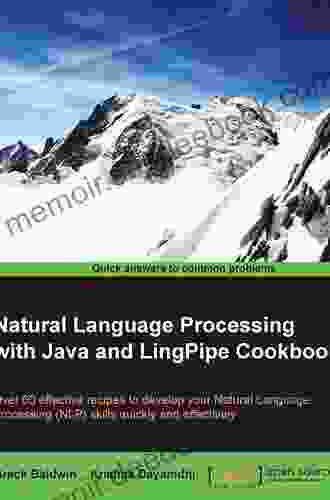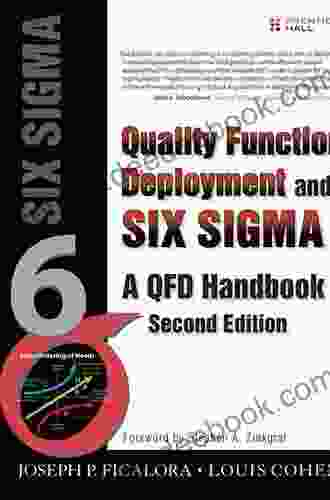Quality Function Deployment (QFD) and Six Sigma: A Comprehensive Guide to Process Improvement

Quality Function Deployment (QFD) and Six Sigma are two of the most widely used process improvement methodologies in the world. QFD is a customer-focused approach that helps organisations to translate customer requirements into product and service features. Six Sigma is a data-driven approach that helps organisations to eliminate defects and improve quality.
4.5 out of 5
| Language | : | English |
| File size | : | 9352 KB |
| Text-to-Speech | : | Enabled |
| Screen Reader | : | Supported |
| Enhanced typesetting | : | Enabled |
| Word Wise | : | Enabled |
| Print length | : | 449 pages |
When used together, QFD and Six Sigma can be a powerful combination for improving product and service quality. QFD helps to ensure that products and services are designed to meet customer needs, while Six Sigma helps to ensure that products and services are produced and delivered with a high degree of quality.
What is Quality Function Deployment (QFD)?
QFD is a process that helps organisations to translate customer requirements into product and service features. QFD is based on the premise that the best way to improve product and service quality is to start by understanding the needs of the customer.
The QFD process typically involves the following steps:
1. Identify customer requirements. The first step in QFD is to identify the customer requirements for the product or service. This can be done through surveys, interviews, or other methods of gathering customer feedback. 2. Prioritize customer requirements. Once the customer requirements have been identified, they need to be prioritized. This can be done using a variety of methods, such as the Analytic Hierarchy Process (AHP). 3. Develop product and service features. The next step is to develop product and service features that will meet the customer requirements. This can be done using a variety of methods, such as brainstorming, mind mapping, or Pugh matrices. 4. Evaluate product and service features. Once the product and service features have been developed, they need to be evaluated to ensure that they meet the customer requirements. This can be done using a variety of methods, such as customer surveys, focus groups, or pilot testing. 5. Implement product and service features. The final step in QFD is to implement the product and service features. This can be done through a variety of methods, such as design engineering, manufacturing, or software development.
What is Six Sigma?
Six Sigma is a data-driven approach that helps organisations to eliminate defects and improve quality. Six Sigma is based on the premise that defects can be eliminated by identifying and removing the root causes of variation.
The Six Sigma process typically involves the following steps:
1. Define the problem. The first step in Six Sigma is to define the problem that needs to be solved. This can be done through a variety of methods, such as process mapping, data analysis, or customer feedback. 2. Measure the problem. The next step is to measure the problem. This can be done through a variety of methods, such as statistical process control (SPC),data collection, or customer surveys. 3. Analyse the problem. Once the problem has been measured, it needs to be analysed to identify the root causes of variation. This can be done through a variety of methods, such as fishbone diagrams, cause-and-effect analysis, or regression analysis. 4. Improve the process. The next step is to improve the process by eliminating the root causes of variation. This can be done through a variety of methods, such as process redesign, equipment upgrades, or training. 5. Control the process. The final step in Six Sigma is to control the process to ensure that it continues to operate at a high level of quality. This can be done through a variety of methods, such as SPC, process audits, or customer feedback.
How can QFD and Six Sigma be used together?
QFD and Six Sigma can be used together to achieve significant improvements in product and service quality. QFD helps to ensure that products and services are designed to meet customer needs, while Six Sigma helps to ensure that products and services are produced and delivered with a high degree of quality.
The following are some examples of how QFD and Six Sigma can be used together:
* To develop new products and services. QFD can be used to identify the customer requirements for a new product or service. Six Sigma can then be used to design and develop the product or service to meet those requirements. * To improve existing products and services. QFD can be used to identify the areas where existing products and services can be improved. Six Sigma can then be used to implement improvements to those products and services. * To reduce costs. QFD can be used to identify the features and functions that are most important to customers. Six Sigma can then be used to eliminate the features and functions that are not important to customers, thereby reducing costs.
QFD and Six Sigma are two powerful process improvement methodologies that can be used together to achieve significant improvements in product and service quality. QFD helps to ensure that products and services are designed to meet customer needs, while Six Sigma helps to ensure that products and services are produced and delivered with a high degree of quality.
When used together, QFD and Six Sigma can help organisations to:
* Improve customer satisfaction * Reduce defects * Improve quality * Reduce costs * Increase productivity
4.5 out of 5
| Language | : | English |
| File size | : | 9352 KB |
| Text-to-Speech | : | Enabled |
| Screen Reader | : | Supported |
| Enhanced typesetting | : | Enabled |
| Word Wise | : | Enabled |
| Print length | : | 449 pages |
Do you want to contribute by writing guest posts on this blog?
Please contact us and send us a resume of previous articles that you have written.
 Book
Book Chapter
Chapter Text
Text Reader
Reader Library
Library E-book
E-book Paragraph
Paragraph Shelf
Shelf Bibliography
Bibliography Preface
Preface Synopsis
Synopsis Footnote
Footnote Manuscript
Manuscript Scroll
Scroll Codex
Codex Tome
Tome Library card
Library card Narrative
Narrative Biography
Biography Autobiography
Autobiography Memoir
Memoir Dictionary
Dictionary Card Catalog
Card Catalog Borrowing
Borrowing Stacks
Stacks Archives
Archives Periodicals
Periodicals Scholarly
Scholarly Lending
Lending Reserve
Reserve Journals
Journals Rare Books
Rare Books Interlibrary
Interlibrary Literacy
Literacy Study Group
Study Group Dissertation
Dissertation Storytelling
Storytelling Awards
Awards Reading List
Reading List Theory
Theory Lawrence Ellsworth
Lawrence Ellsworth Tori Chase
Tori Chase Hahrie Han
Hahrie Han Trevor Hill
Trevor Hill Bill Bradley
Bill Bradley Theodore Roosevelt
Theodore Roosevelt Ruth Perry
Ruth Perry David Conger
David Conger John Kruth
John Kruth Miri Rubin
Miri Rubin Lexi George
Lexi George Sam Stall
Sam Stall Krysia Jopek
Krysia Jopek Rey Chow
Rey Chow Vet Adams
Vet Adams John C Maxwell
John C Maxwell Peter Philippson
Peter Philippson Thomas R Horn
Thomas R Horn Marc Robinson
Marc Robinson Henry James
Henry James
Light bulbAdvertise smarter! Our strategic ad space ensures maximum exposure. Reserve your spot today!

 Truman CapoteElena Ransom and the Firebird Unit: Unlocking the Secrets of the Supernatural
Truman CapoteElena Ransom and the Firebird Unit: Unlocking the Secrets of the Supernatural
 Maurice ParkerThe Ultimate Guide to Keeping Birman Cats As Pets: A Comprehensive Overview
Maurice ParkerThe Ultimate Guide to Keeping Birman Cats As Pets: A Comprehensive Overview
 Lord ByronAn Army Doctor's American Revolution Journal 1775-1783: A First-Hand Account...
Lord ByronAn Army Doctor's American Revolution Journal 1775-1783: A First-Hand Account... Devon MitchellFollow ·13.5k
Devon MitchellFollow ·13.5k Gordon CoxFollow ·8.9k
Gordon CoxFollow ·8.9k Eric NelsonFollow ·17.5k
Eric NelsonFollow ·17.5k Gabriel MistralFollow ·4.3k
Gabriel MistralFollow ·4.3k Tim ReedFollow ·18.5k
Tim ReedFollow ·18.5k Camden MitchellFollow ·7.6k
Camden MitchellFollow ·7.6k Jacob HayesFollow ·4.1k
Jacob HayesFollow ·4.1k Charles BukowskiFollow ·2.5k
Charles BukowskiFollow ·2.5k

 Vernon Blair
Vernon BlairHow to Get a Woman to Pay for You: A Comprehensive Guide...
In the modern dating...

 Levi Powell
Levi PowellPrinciples and Theory for Data Mining and Machine...
Data mining and machine learning are two...

 Andrew Bell
Andrew BellMirrors For The Mind: Milestones In Discovery And...
Mirrors have been a part of human history...

 Alec Hayes
Alec HayesDelving into Natural Language Processing with Java and...
Natural Language Processing (NLP) is an...
4.5 out of 5
| Language | : | English |
| File size | : | 9352 KB |
| Text-to-Speech | : | Enabled |
| Screen Reader | : | Supported |
| Enhanced typesetting | : | Enabled |
| Word Wise | : | Enabled |
| Print length | : | 449 pages |










